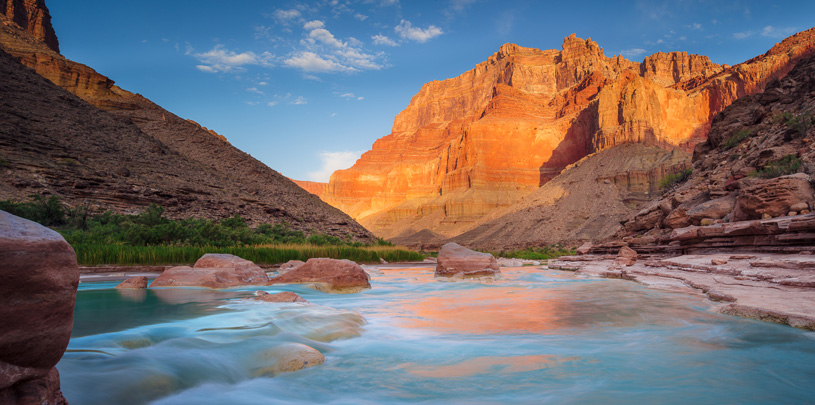
 by Ellen Heyn, Communications Associate
by Ellen Heyn, Communications Associate
Last week, Russell Begaye won a landslide victory in the Navajo Nation’s presidential election, putting an end to a tumultuous election cycle that left lame duck president Ben Shelly (who came in 7th in the primary) in office for months after his term should have expired. That means Shelly will finally be leaving office, taking his dreams of pushing the proposed Grand Canyon Escalade tramway resort through the approval process along with him. But even with Escalade’s champion out of play, the Confluence Partners have not yet backed down.
It’s time for another round of calling Escalade’s bluffs.
The election results suggest that the Navajo Nation is ready for a new style of leadership. The new president-elect, Russell Begaye, was the underdog candidate. He signed a petition opposing the Escalade development during his campaign. His opponent, Joe Shirley, remained neutral, at least publically (he was the sitting president in 2009 when the Escalade project was first introduced).
Begaye won resoundingly, capturing 62 percent of the votes.
When you talk about Escalade or any projects out there, we need to involve … the voice of the local people, rather than allowing big corporations to make those decisions. Yes, we’re trying to create jobs, but we’re doing it in the wrong places and in the wrong way, and (Escalade) is one of those.
– Russell Begaye, campaign statement
The Tribal Council doesn’t seem to be interested in the project either. During the four years the Confluence Partners have been trying to obtain the council’s necessary approval, not a single delegate has ever spoken in support of the project or sponsored the legislation required to approve it.
The political landscape on the Navajo Nation is still uncertain given the new administration, but the voices of Navajo residents who oppose the Escalade are being heard.
The Confluence Partners claim the tramway and river walk will give tourists a real wilderness experience. Yet, according to their own estimates, there will be as many as 1,350 people on the river walk at any given time. You don’t have to be a backcountry snob to realize that sharing a 1,500 ft long river walk with 1,350 people is not wilderness.
In fact, the Wilderness Act defines wilderness as, “an area possessing outstanding opportunities for solitude or primitive and unconfined types of recreation.” And the park service limits permits in wilderness areas to reduce the number of interactions hikers have with each other on the trail.
The Escalade’s continuous conveyor belt dumping people into the bottom of the Grand Canyon is no more “wild” than the domesticated squirrels that munch potato chips on the South Rim.
River trips cost several thousand dollars, and helicopter rides several hundred. The price of those activities is prohibitive, but the cost of hiking down to the river is less than a ticket to the Grand Canyon Skywalk, and presumably less than the Escalade tramway ride (price not disclosed).

Hiking is the most economical way to experience the canyon. Even so, only five percent of park visitors spend a night in the backcountry and fewer than ten percent day-hike the corridor trails. Age, fitness levels, and physical disabilities are limitations to experiencing the canyon, and the tramway might help a small percentage of people. But if a blind kayaker can navigate 277 miles through the canyon’s raging whitewater, then the remaining 90 percent of us who are just a little out of shape could muster the energy to at least step foot below the rim.
The Confluence Partners don’t elaborate on the numbers they throw around, and while they might be using complex modeling to arrive at the figures, what they communicate to the public suggests the estimates come from thin air. Take for example the project generating $350-450 million for the local community each year. Where does that come from?
Their projections leave us speculating, but this is our best guess:
The Confluence Partners estimate they’ll capture 50 percent of park visitors (a lofty goal—Grand Canyon National Park receives roughly 4.5 million visitors each year). This month, the National Park Service issued a report that shows Grand Canyon National Park to have a cumulative benefit to the local economy of just over $700 million. Why not halve the park service’s financial calculations as well, since they anticipate attracting half its visitors? That puts Escalade’s benefit to the local economy right in their cited range of $350-450 million.
These community benefits include jobs and money spent in nearby towns, but are the Confluence Partners taking into account the Covenant Not to Compete clause they wrote into the master agreement that negates some of these so-called benefits? The non-compete clause would block artisans, jewelry makers, and fry-bread stands from setting up shop on a 40,000 acre area surrounding the proposed development. The developers would decide what, if any, competition to allow in their exclusive economic zone.
What if [the developers] decide that cattle and sheep are economic competition and they take them out of their exclusion zone?
– Jason Nez, rancher and Save the Confluence member
Yes, the Navajo Nation needs jobs, but empty promises are not the answer. The Grand Canyon Trust’s Native America program is working with tribes on culturally-driven, locally-based alternative economic development initiatives.
The Colorado River below Glen Canyon Dam is heating up. Find out why.
Read MoreGroundwater pumping at a uranium mine near the Grand Canyon will affect the canyon's springs, scientists says.
Read MoreArizona Governor Katie Hobbs is the latest elected official to call for an environmental review of Pinyon Plain uranium mine.
Read More